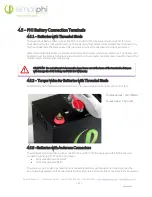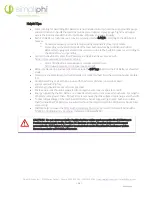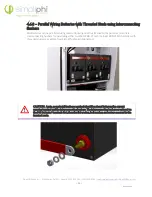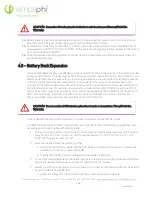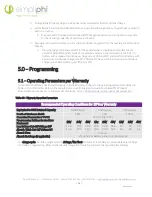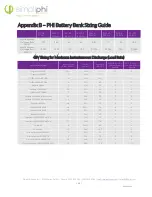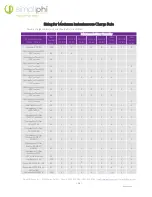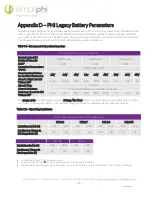
REV020620
SimpliPhi Power, Inc. | 3100 Camino Del Sol | Oxnard, CA 93030, USA | (805) 640-6700 |
| 30 |
there must be less than 0.01% of the substance by weight at raw homogeneous materials levels. For Lead,
PBB, and PBDE, there must be no more than 0.1% of the material, when calculated by weight at raw
homogeneous materials. Any RoHS compliant component must have 100 ppm or less of mercury and the
mercury must not have been intentionally added to the component. In the EU, some military and medical
equipment are exempt from RoHS compliance.
B.2
–
Green Attributes, Environmental & Ecological Considerations
B.2.1
–
Materials
The primary materials (lithium, iron, phosphate) that make up PHI Batteries are environmentally benign and
pose very few polluting or environmentally degrading by-products in the harvesting and refinement
processes. This is especially true when compared to those of lead acid, NMC, NCA, LCO, NiCad, and NiMH
batteries.
B.2.2
–
By Products
There are no toxic by-products associated with the manufacturing or use of PHI Batteries, such as off-
gassing hydrogen, sulfuric acid spillage, lead contamination, or explosive chemicals.
B.2.3
–
Operation
There is no need for maintenance, such as adding water or chemicals, nor is there corrosion of terminals or
containment facilities, or dispersion of fumes as with other battery types. Once installed, PHI Batteries are
maintenance free as long as all the Installation Manual, Integration Guidelines and Warranty requirements
are adhered to.
B.2.4
–
Life Cycles
PHI Batteries are designed for thousands of cycles while maintaining 80 percent or more of their initial
capacity. To achieve this, it is critical to follow the operating conditions outlined in the Warranty.
B.2.5
–
Disposal
PHI products are non-hazardous, may be disposed of without damage to the ecosystem, and returned to the
earth, while easily recombining with the elements without harmful by-products. The outer casing and
brackets contain steel, aluminum, copper, cardboard, and recyclable plastic. Lithium Ferrous Phosphate
(LFP) materials can also be recycled through established battery centers if desired.
B.2.6
–
Lithium Ferrous Phosphate Batteries and the Environment
As the use of this battery chemistry in larger batteries becomes more common, questions of sustainability
and environmental impact inevitably arise. Of the lithium ferrous phosphate chemistries being considered
for large format batteries, SimpliPhi Power believes that batteries based on our proprietary lithium ferrous
phosphate chemistry and circuitry offer a clear advantage, not only over alternate Li-ion chemistries (lithium
cobalt oxide), but all battery chemistries that are currently commercially available. This belief is based on the
minimal environmental impact associated with the manufacturing of PHI Batteries, the extended cycle life
and the significantly smaller end-of-life footprint that results from the use of PHI Batteries.
B.3
–
Summary


